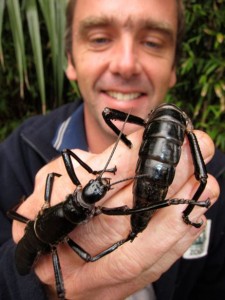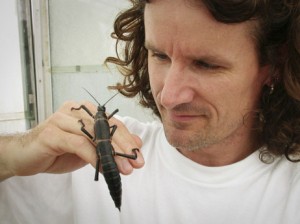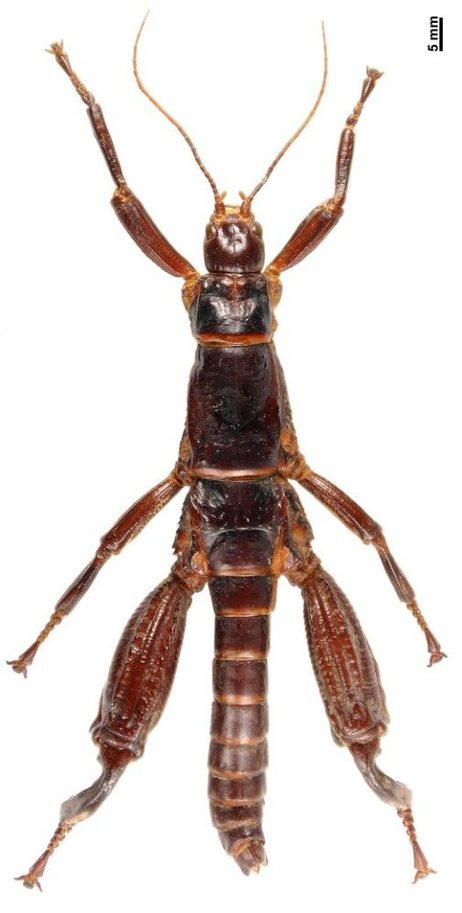Extinct For 80 Years: Giant Walking Stick Rediscovered
Posted by: Loren Coleman on March 1st, 2012
Two Australian scientists, David Priddel and Nicholas Carlile have rediscovered Dryococelus australis, a giant walking stick, found on “Ball’s Pyramid.” It was thought to have died out.
It’s a stick insect, a critter that masquerades as a piece of wood, and the Lord Howe Island version was so large — as big as a human hand — that the Europeans labeled it a “tree lobster” because of its size and hard, lobsterlike exoskeleton. It was 12 centimeters long and the heaviest flightless stick insect in the world. Local fishermen used to put them on fishing hooks and use them as bait.
Its supposed extinction and then rediscovery is quite a story.
One day in 1918, a supply ship, the S.S. Makambo from Britain, ran aground at Lord Howe Island and had to be evacuated. One passenger drowned. The rest were put ashore. It took nine days to repair the Makambo, and during that time, some black rats managed to get from the ship to the island, where they instantly discovered a delicious new rat food: giant stick insects. Two years later, the rats were everywhere and the tree lobsters were gone.
Totally gone. After 1920, there wasn’t a single sighting. By 1960, the Lord Howe stick insect, Dryococelus australis, was presumed extinct.
 Ball’s Pyramid in the Tasman sea is located 19 kilometers from Lord Howe Island east of Australia.
Ball’s Pyramid in the Tasman sea is located 19 kilometers from Lord Howe Island east of Australia.


Fast forward to 2001, when two Australian scientists, David Priddel and Nicholas Carlile, with two assistants, decided to take a closer look. From the water, they’d seen a few patches of vegetation that just might support walking sticks. So, they boated over. (“Swimming would have been much easier,” Carlile said, “but there are too many sharks.”) They crawled up the vertical rock face to about 500 feet, where they found a few crickets, nothing special. But on their way down, on a precarious, unstable rock surface, they saw a single melaleuca bush peeping out of a crack and, underneath, what looked like fresh droppings of some large insect.
Where, they wondered, did that poop come from?
The only thing to do was to go back up after dark, with flashlights and cameras, to see if the pooper would be out taking a nighttime walk. Nick Carlile and a local ranger, Dean Hiscox, agreed to make the climb. And with flashlights, they scaled the wall till they reached the plant, and there, spread out on the bushy surface, were two enormous, shiny, black-looking bodies. And below those two, slithering into the muck, were more, and more … 24 in all. All gathered near this one plant.

Nick Carlile, seen here with the Lord Howe Island stick insect, discovered the thought-to-be extinct phasmid in 2001 on Ball’s Pyramid.
When the team went back to collect them, it turned out there had been a rock slide on the mountain, and at first they feared that the whole population had been wiped out. But when they got back up to the site, on Valentine’s Day 2003, the animals were still there, sitting on and around their bush.
 Male Lord Howe Island Stick Insect K.
Male Lord Howe Island Stick Insect K.
For more, see the Source.
Thanks to Skylaire Alfvegren and others for the news tip.
About Loren Coleman
Loren Coleman is one of the world’s leading cryptozoologists, some say “the” leading living cryptozoologist. Certainly, he is acknowledged as the current living American researcher and writer who has most popularized cryptozoology in the late 20th and early 21st centuries.
Starting his fieldwork and investigations in 1960, after traveling and trekking extensively in pursuit of cryptozoological mysteries, Coleman began writing to share his experiences in 1969. An honorary member of Ivan T. Sanderson’s Society for the Investigation of the Unexplained in the 1970s, Coleman has been bestowed with similar honorary memberships of the North Idaho College Cryptozoology Club in 1983, and in subsequent years, that of the British Columbia Scientific Cryptozoology Club, CryptoSafari International, and other international organizations. He was also a Life Member and Benefactor of the International Society of Cryptozoology (now-defunct).
Loren Coleman’s daily blog, as a member of the Cryptomundo Team, served as an ongoing avenue of communication for the ever-growing body of cryptozoo news from 2005 through 2013. He returned as an infrequent contributor beginning Halloween week of 2015.
Coleman is the founder in 2003, and current director of the International Cryptozoology Museum in Portland, Maine.










It is amazing when you consider the perfect storm of events that saved 24 of these insects. It took years for the govn’t to agree to allow 2 mating sets to be recovered from the island for breeding. The first set died quickly but the second set produced over 700 healthy offspring over the course of the next few years.
Now the hard part is ‘what do they do now’? They can’t return them to Lord Howe Island as the rats will simply eat them into extinction once more, but where else can they survive and thrive?
And while I understand their importance in the biological setting I personally find insects of that size to be nightmare fuel. I’m sure I’m not alone in my queasiness around them so I wonder if they can get the human population at large to root for and conserve these creatures if they are returned to the wild? I know it worked with the praying mantis in some areas, so maybe there is hope.
flame821- I’m not sure where the popular idea that praying mantises are protected came from, but it is not true.
Contrary to that popular misconception, the praying mantis has never been federally protected in any state and it has never been illegal to kill one. It is not, nor ever has been listed on any endangered species list within the United States and is not threatened. There are no fines for killing one and no laws protecting them anywhere in the U.S.
Anyway, rats have always been a formidable invasive species in island habitats. Being the generalist feeders they are, with their high reproductive rates, hardiness, predatory habits, and general “hard- to-kill-edness,” rats can cause a lot of problems.
On Lord Howe Island, for instance, the rats are responsible to some degree or another for the decline or extinction of many species of birds, lizards, and even the extinction of two large land snails once found on the island, not to mention plants and insects such as our walking stick friend here. (Thanks for the nightmares, by the way 🙂 ) This has all happened within a hundred years of when the rats were originally introduced. It is clear that if we are to get Lord Howe’s ecology back on track, the rats have to go.
Rats are notoriously difficult to control and get rid of, but I’d say that all is not necessarily lost. They have been successfully eradicated from a number of inhabited islands that were facing the same ecological threat, and currently ongoing efforts have been underway to implement similar rat eradication programs on Lord Howe island as well. There have already been successful eradications of feral pigs and cats on the island, as well as a sharp reduction in the feral goat population, all species that similarly caused a great deal of damage to the island ecosystem. Maybe they can pull it off with rats too.
I’d say that the success to conservation of these walking sticks lies not only in winning public acceptance of such nightmarish bugs, but also in getting rid of the rats, which also relies on public acceptance.
Any large scale effort to eradicate the rats requires island inhabitants to accept certain inconveniences and limitations on their daily activities. In the case of using poisons there may also be public health concerns whether the actual threat is there or not. A large scale eradication program, such as that required to rid this island of rats, requires full support and cooperation from the community in order have a good chance of success.
So the public needs to be totally on board with how the eradication program will affect them as well as dealing with the idea of waking up in the middle of the night with one of these walking pieces of nightmare fuel crawling on their face. 🙂
Mystery Man- praying mantis is a colloquial term for an order, Mantodea, that exist in various species worldwide. It is possible that flame821 was referring to somewhere… not america. 🙂
Thylo- You… yes, that may be so. 🙂
Aaaw, you don’t like those big six-legged creatures, mystery_man? think of them as fairies, and the nightmares will end 😉
I don’t know what the proper name is.
Tis a greenish stick like insect with large mandibles, the females eat the males after mating. I was told they were a protected insect by my biology teacher way back in grammar school when we had to collect insects (not bugs, insects, he was very stern regarding this, he didn’t want arachnids) for our marking period project. He told us grasshoppers and crickets were fine but under no circumstances were we to touch a praying mantis as they were protected by law. Never thought to question anyone about it as I’ve only seen a few in the wild over my lifetime.
@flame821- what part of the world was that in? just looking it up quickly last night it doesn’t seem that any mantids are endangered in north america (though the canadian population (in southern B.C.) is naturally small as it is an extension of the larger population south of the border), so I figured you were talking about asia or africa or oceania. /shrug
so figured rather than guessing I would just ask. 🙂
btw- I saw a documentary on mantids last week and there are some amazing forms out there… i had no idea they were so diverse (and very few species practice the famous post-coital cannibalism).
back at the thread topic- amazing phasmids! i hope that they can protect them. It would be great if the will was there to destroy the invasive rats (from Lord Howe Island) and re-introduce the phasmids to their extirpated range, but I don’t know if that is feasible.
It is not illegal to catch or kill a praying mantis in the USA.
Indeed, the story is an urban/rural myth.
@ thylo –
I can’t remember which school but I was definitely in North America, either Montreal or Philadelphia. (I know I wasn’t in the UK yet) So apparently my teacher was either repeating an urban myth or he didn’t want us taking beneficial insects (spiders, mantis or anything that eats other bugs) out of the environment and decided to tell us this to make sure we didn’t collect them. -shrugs- no ideal, but in that day and age you did what teacher said as authority figures weren’t really questioned and corporal punishment was still allowed under ‘loco parentis’ (temporary/replacement parents?) or something of that nature.
At least in Germany it is strictly prohibited to kill, catch or keep the native preying mantis. But this is also because there is only one single species of mantid which occurs in Germany, Mantis religiosa, and it inhabits only a small handful of locations, mainly areas with very mild climate.
This species was also introduced to the United States and Canada.
red_pill_junkie- I have an appreciation for all of nature’s creatures, including these giant walking sticks. These giant bugs have every right to exist as any other creature on this planet, as long as they are doing it well away from me and not crawling around on me like the one creeping up your back right now.
You’re welcome. 🙂
LOL, I guess we both would have made poor sidekicks for Indy. 😉